Strategic Approaches in Nonprofit HR Management and Advocacy
VerifiedAdded on 2020/04/13
|15
|4016
|41
AI Summary
The study of strategic human resource management in nonprofit organizations provides essential insights into how these entities can improve efficiency and effectiveness amidst financial limitations and service demand pressures. Drawing on resource-based view (RBV) and resource dependence theory (RDT), this analysis presents a model that encapsulates the determinants of strategic HRM specific to nonprofits. It introduces guiding principles, strategy types, and propositions crucial for understanding the complex interplay within nonprofit human resource management systems (SNHRM). The research highlights three primary challenges: increasing financial cutbacks, heightened demand for services, and the push towards performance-related management. Nonprofits are encouraged to adopt a strategic orientation in their HR architecture to address these issues effectively. A case study involving ten health and social services NPOs reveals a trend toward a dominant strategic HRM configuration. This shift is significant as it indicates how nonprofits can optimize their human resource practices to manage internal and external environmental challenges successfully. The assignment provides a foundation for future research while offering practical frameworks for SHRM planning and execution in the nonprofit sector.

Running head: LITERATURE REVIEW
Strategic management in non-profit organizations, e.g. charities and NGOs
Name of the Student
Name of the University
Author Note
Strategic management in non-profit organizations, e.g. charities and NGOs
Name of the Student
Name of the University
Author Note
Paraphrase This Document
Need a fresh take? Get an instant paraphrase of this document with our AI Paraphraser
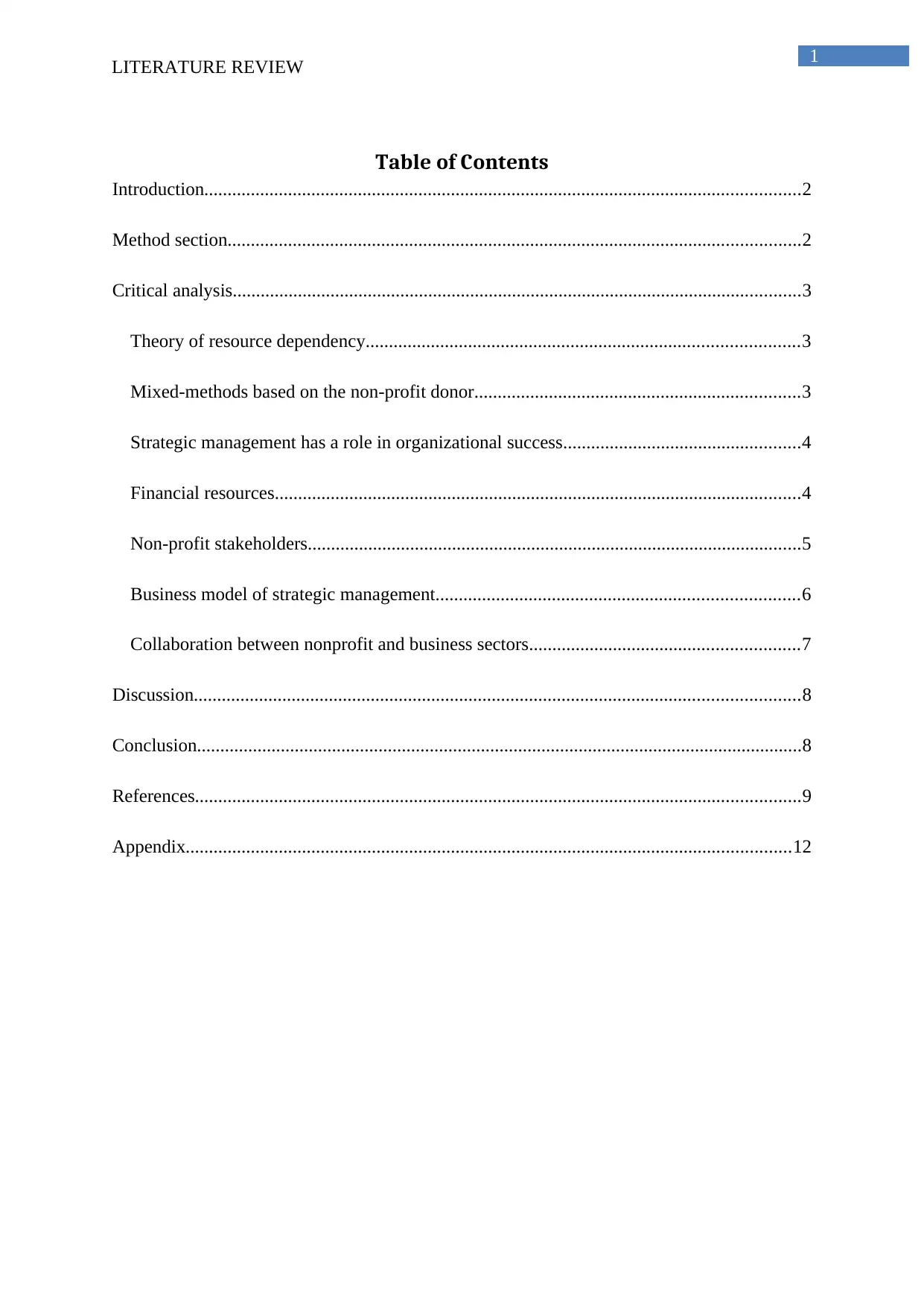
1
LITERATURE REVIEW
Table of Contents
Introduction................................................................................................................................2
Method section...........................................................................................................................2
Critical analysis..........................................................................................................................3
Theory of resource dependency.............................................................................................3
Mixed-methods based on the non-profit donor......................................................................3
Strategic management has a role in organizational success...................................................4
Financial resources.................................................................................................................4
Non-profit stakeholders..........................................................................................................5
Business model of strategic management..............................................................................6
Collaboration between nonprofit and business sectors..........................................................7
Discussion..................................................................................................................................8
Conclusion..................................................................................................................................8
References..................................................................................................................................9
Appendix..................................................................................................................................12
LITERATURE REVIEW
Table of Contents
Introduction................................................................................................................................2
Method section...........................................................................................................................2
Critical analysis..........................................................................................................................3
Theory of resource dependency.............................................................................................3
Mixed-methods based on the non-profit donor......................................................................3
Strategic management has a role in organizational success...................................................4
Financial resources.................................................................................................................4
Non-profit stakeholders..........................................................................................................5
Business model of strategic management..............................................................................6
Collaboration between nonprofit and business sectors..........................................................7
Discussion..................................................................................................................................8
Conclusion..................................................................................................................................8
References..................................................................................................................................9
Appendix..................................................................................................................................12
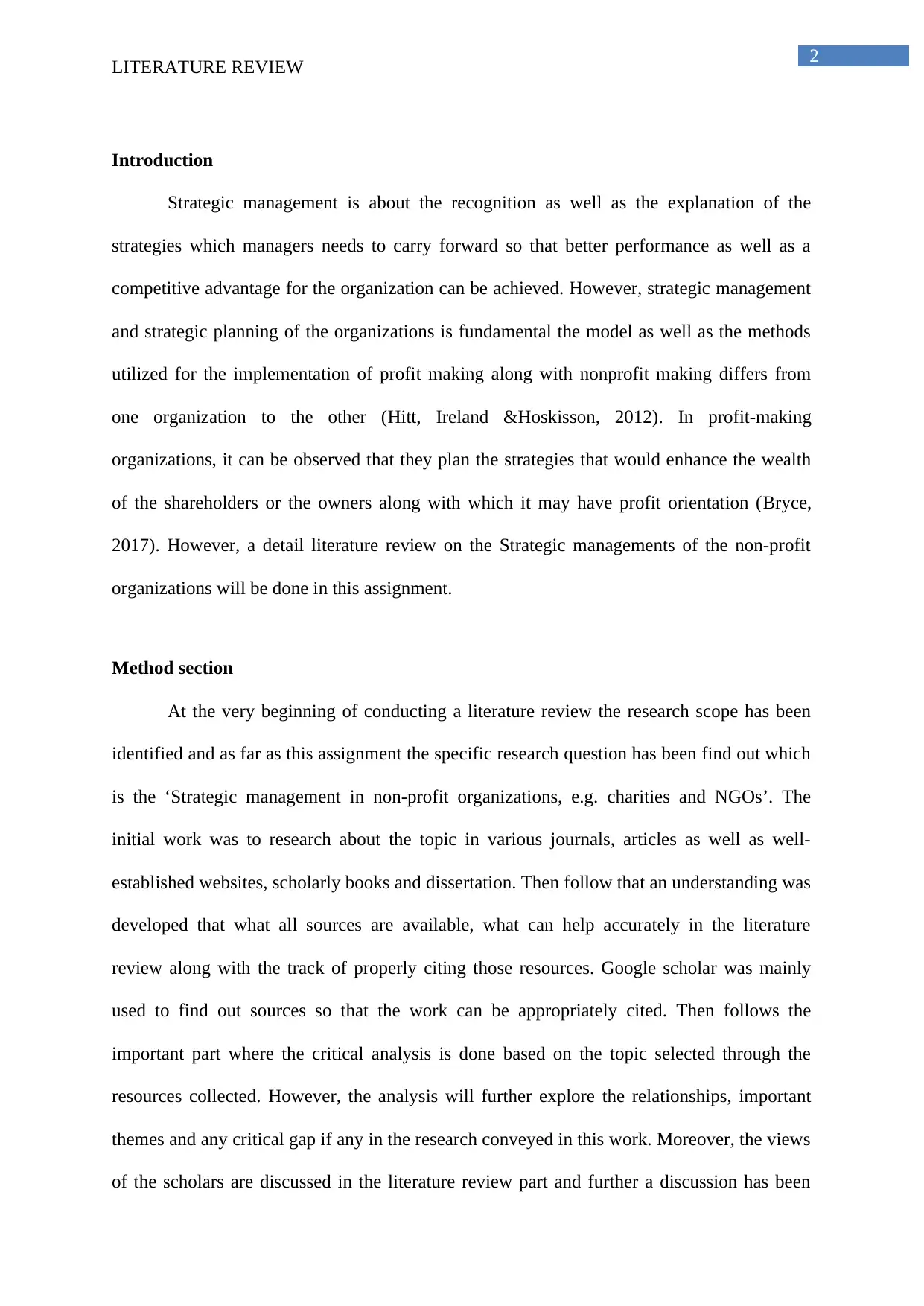
2
LITERATURE REVIEW
Introduction
Strategic management is about the recognition as well as the explanation of the
strategies which managers needs to carry forward so that better performance as well as a
competitive advantage for the organization can be achieved. However, strategic management
and strategic planning of the organizations is fundamental the model as well as the methods
utilized for the implementation of profit making along with nonprofit making differs from
one organization to the other (Hitt, Ireland &Hoskisson, 2012). In profit-making
organizations, it can be observed that they plan the strategies that would enhance the wealth
of the shareholders or the owners along with which it may have profit orientation (Bryce,
2017). However, a detail literature review on the Strategic managements of the non-profit
organizations will be done in this assignment.
Method section
At the very beginning of conducting a literature review the research scope has been
identified and as far as this assignment the specific research question has been find out which
is the ‘Strategic management in non-profit organizations, e.g. charities and NGOs’. The
initial work was to research about the topic in various journals, articles as well as well-
established websites, scholarly books and dissertation. Then follow that an understanding was
developed that what all sources are available, what can help accurately in the literature
review along with the track of properly citing those resources. Google scholar was mainly
used to find out sources so that the work can be appropriately cited. Then follows the
important part where the critical analysis is done based on the topic selected through the
resources collected. However, the analysis will further explore the relationships, important
themes and any critical gap if any in the research conveyed in this work. Moreover, the views
of the scholars are discussed in the literature review part and further a discussion has been
LITERATURE REVIEW
Introduction
Strategic management is about the recognition as well as the explanation of the
strategies which managers needs to carry forward so that better performance as well as a
competitive advantage for the organization can be achieved. However, strategic management
and strategic planning of the organizations is fundamental the model as well as the methods
utilized for the implementation of profit making along with nonprofit making differs from
one organization to the other (Hitt, Ireland &Hoskisson, 2012). In profit-making
organizations, it can be observed that they plan the strategies that would enhance the wealth
of the shareholders or the owners along with which it may have profit orientation (Bryce,
2017). However, a detail literature review on the Strategic managements of the non-profit
organizations will be done in this assignment.
Method section
At the very beginning of conducting a literature review the research scope has been
identified and as far as this assignment the specific research question has been find out which
is the ‘Strategic management in non-profit organizations, e.g. charities and NGOs’. The
initial work was to research about the topic in various journals, articles as well as well-
established websites, scholarly books and dissertation. Then follow that an understanding was
developed that what all sources are available, what can help accurately in the literature
review along with the track of properly citing those resources. Google scholar was mainly
used to find out sources so that the work can be appropriately cited. Then follows the
important part where the critical analysis is done based on the topic selected through the
resources collected. However, the analysis will further explore the relationships, important
themes and any critical gap if any in the research conveyed in this work. Moreover, the views
of the scholars are discussed in the literature review part and further a discussion has been
⊘ This is a preview!⊘
Do you want full access?
Subscribe today to unlock all pages.

Trusted by 1+ million students worldwide
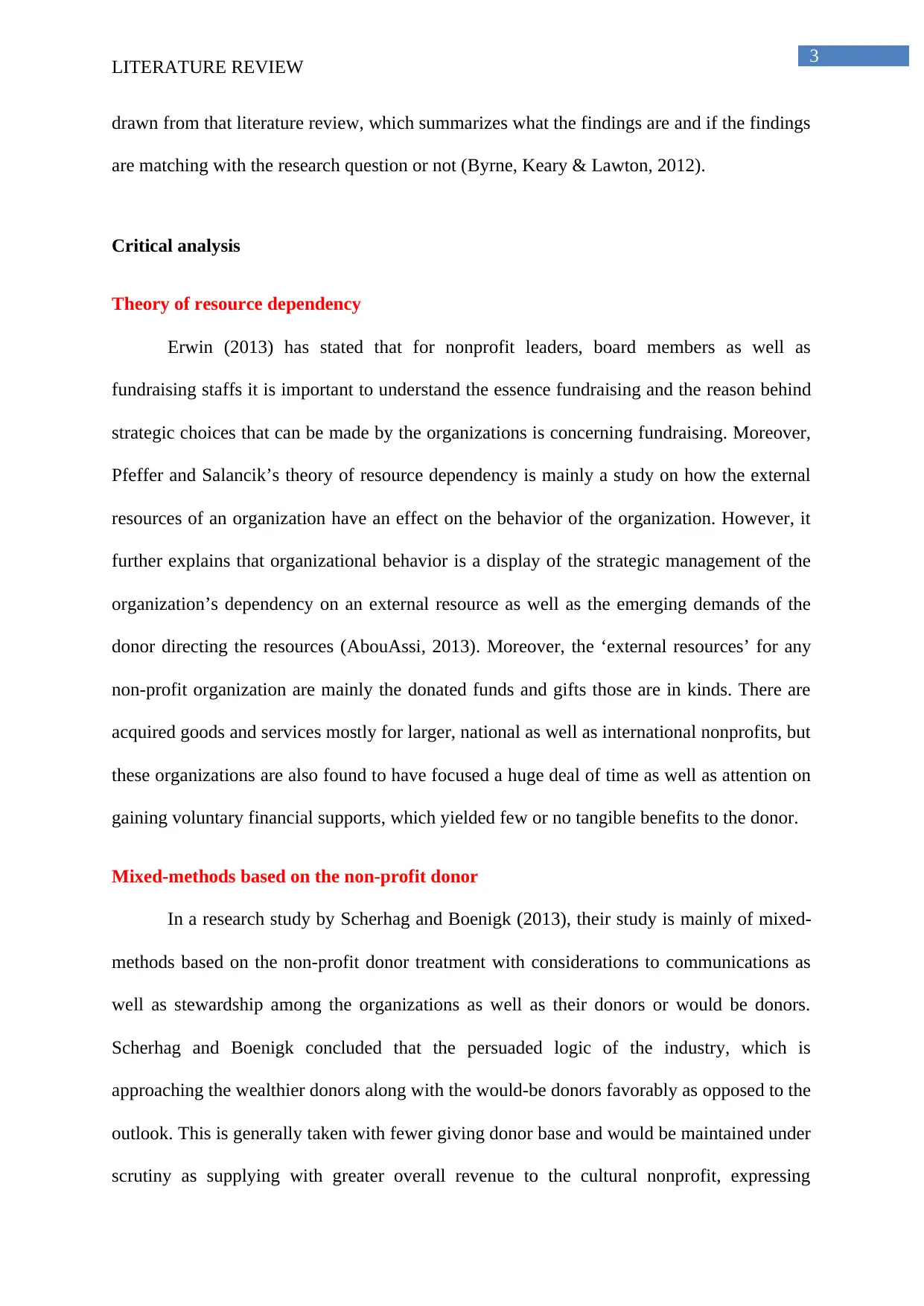
3
LITERATURE REVIEW
drawn from that literature review, which summarizes what the findings are and if the findings
are matching with the research question or not (Byrne, Keary & Lawton, 2012).
Critical analysis
Theory of resource dependency
Erwin (2013) has stated that for nonprofit leaders, board members as well as
fundraising staffs it is important to understand the essence fundraising and the reason behind
strategic choices that can be made by the organizations is concerning fundraising. Moreover,
Pfeffer and Salancik’s theory of resource dependency is mainly a study on how the external
resources of an organization have an effect on the behavior of the organization. However, it
further explains that organizational behavior is a display of the strategic management of the
organization’s dependency on an external resource as well as the emerging demands of the
donor directing the resources (AbouAssi, 2013). Moreover, the ‘external resources’ for any
non-profit organization are mainly the donated funds and gifts those are in kinds. There are
acquired goods and services mostly for larger, national as well as international nonprofits, but
these organizations are also found to have focused a huge deal of time as well as attention on
gaining voluntary financial supports, which yielded few or no tangible benefits to the donor.
Mixed-methods based on the non-profit donor
In a research study by Scherhag and Boenigk (2013), their study is mainly of mixed-
methods based on the non-profit donor treatment with considerations to communications as
well as stewardship among the organizations as well as their donors or would be donors.
Scherhag and Boenigk concluded that the persuaded logic of the industry, which is
approaching the wealthier donors along with the would-be donors favorably as opposed to the
outlook. This is generally taken with fewer giving donor base and would be maintained under
scrutiny as supplying with greater overall revenue to the cultural nonprofit, expressing
LITERATURE REVIEW
drawn from that literature review, which summarizes what the findings are and if the findings
are matching with the research question or not (Byrne, Keary & Lawton, 2012).
Critical analysis
Theory of resource dependency
Erwin (2013) has stated that for nonprofit leaders, board members as well as
fundraising staffs it is important to understand the essence fundraising and the reason behind
strategic choices that can be made by the organizations is concerning fundraising. Moreover,
Pfeffer and Salancik’s theory of resource dependency is mainly a study on how the external
resources of an organization have an effect on the behavior of the organization. However, it
further explains that organizational behavior is a display of the strategic management of the
organization’s dependency on an external resource as well as the emerging demands of the
donor directing the resources (AbouAssi, 2013). Moreover, the ‘external resources’ for any
non-profit organization are mainly the donated funds and gifts those are in kinds. There are
acquired goods and services mostly for larger, national as well as international nonprofits, but
these organizations are also found to have focused a huge deal of time as well as attention on
gaining voluntary financial supports, which yielded few or no tangible benefits to the donor.
Mixed-methods based on the non-profit donor
In a research study by Scherhag and Boenigk (2013), their study is mainly of mixed-
methods based on the non-profit donor treatment with considerations to communications as
well as stewardship among the organizations as well as their donors or would be donors.
Scherhag and Boenigk concluded that the persuaded logic of the industry, which is
approaching the wealthier donors along with the would-be donors favorably as opposed to the
outlook. This is generally taken with fewer giving donor base and would be maintained under
scrutiny as supplying with greater overall revenue to the cultural nonprofit, expressing
Paraphrase This Document
Need a fresh take? Get an instant paraphrase of this document with our AI Paraphraser
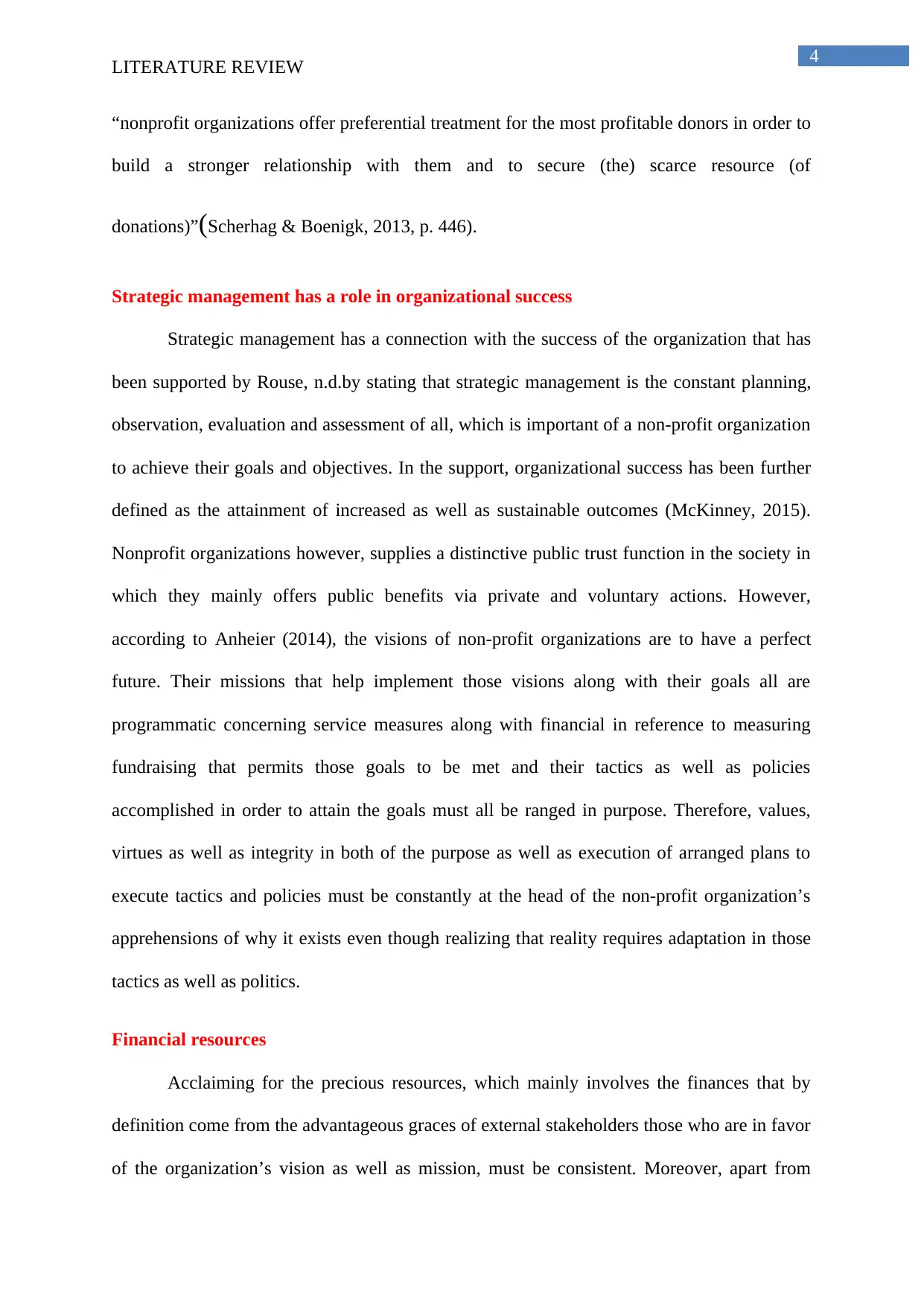
4
LITERATURE REVIEW
“nonprofit organizations offer preferential treatment for the most profitable donors in order to
build a stronger relationship with them and to secure (the) scarce resource (of
donations)”(Scherhag & Boenigk, 2013, p. 446).
Strategic management has a role in organizational success
Strategic management has a connection with the success of the organization that has
been supported by Rouse, n.d.by stating that strategic management is the constant planning,
observation, evaluation and assessment of all, which is important of a non-profit organization
to achieve their goals and objectives. In the support, organizational success has been further
defined as the attainment of increased as well as sustainable outcomes (McKinney, 2015).
Nonprofit organizations however, supplies a distinctive public trust function in the society in
which they mainly offers public benefits via private and voluntary actions. However,
according to Anheier (2014), the visions of non-profit organizations are to have a perfect
future. Their missions that help implement those visions along with their goals all are
programmatic concerning service measures along with financial in reference to measuring
fundraising that permits those goals to be met and their tactics as well as policies
accomplished in order to attain the goals must all be ranged in purpose. Therefore, values,
virtues as well as integrity in both of the purpose as well as execution of arranged plans to
execute tactics and policies must be constantly at the head of the non-profit organization’s
apprehensions of why it exists even though realizing that reality requires adaptation in those
tactics as well as politics.
Financial resources
Acclaiming for the precious resources, which mainly involves the finances that by
definition come from the advantageous graces of external stakeholders those who are in favor
of the organization’s vision as well as mission, must be consistent. Moreover, apart from
LITERATURE REVIEW
“nonprofit organizations offer preferential treatment for the most profitable donors in order to
build a stronger relationship with them and to secure (the) scarce resource (of
donations)”(Scherhag & Boenigk, 2013, p. 446).
Strategic management has a role in organizational success
Strategic management has a connection with the success of the organization that has
been supported by Rouse, n.d.by stating that strategic management is the constant planning,
observation, evaluation and assessment of all, which is important of a non-profit organization
to achieve their goals and objectives. In the support, organizational success has been further
defined as the attainment of increased as well as sustainable outcomes (McKinney, 2015).
Nonprofit organizations however, supplies a distinctive public trust function in the society in
which they mainly offers public benefits via private and voluntary actions. However,
according to Anheier (2014), the visions of non-profit organizations are to have a perfect
future. Their missions that help implement those visions along with their goals all are
programmatic concerning service measures along with financial in reference to measuring
fundraising that permits those goals to be met and their tactics as well as policies
accomplished in order to attain the goals must all be ranged in purpose. Therefore, values,
virtues as well as integrity in both of the purpose as well as execution of arranged plans to
execute tactics and policies must be constantly at the head of the non-profit organization’s
apprehensions of why it exists even though realizing that reality requires adaptation in those
tactics as well as politics.
Financial resources
Acclaiming for the precious resources, which mainly involves the finances that by
definition come from the advantageous graces of external stakeholders those who are in favor
of the organization’s vision as well as mission, must be consistent. Moreover, apart from
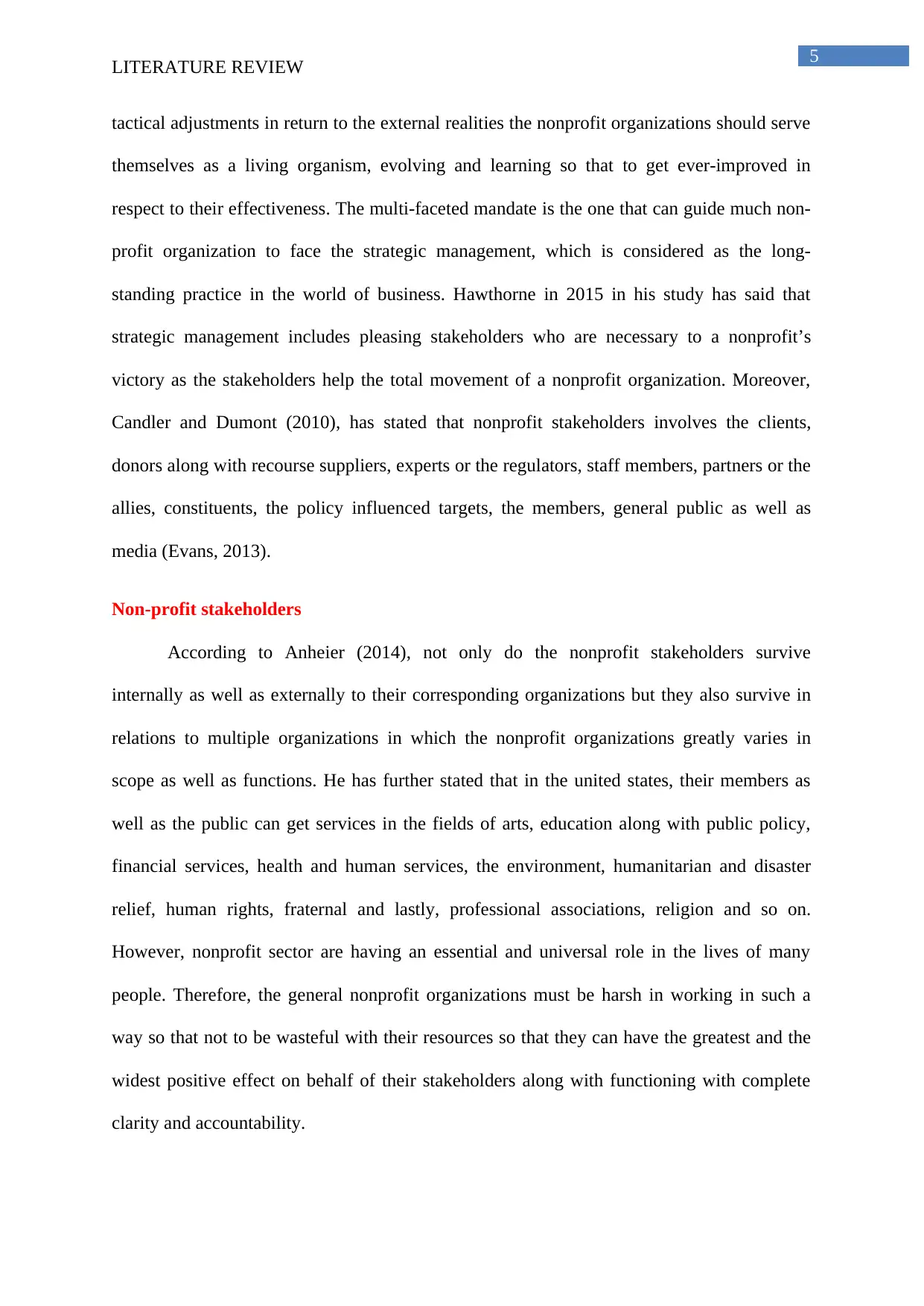
5
LITERATURE REVIEW
tactical adjustments in return to the external realities the nonprofit organizations should serve
themselves as a living organism, evolving and learning so that to get ever-improved in
respect to their effectiveness. The multi-faceted mandate is the one that can guide much non-
profit organization to face the strategic management, which is considered as the long-
standing practice in the world of business. Hawthorne in 2015 in his study has said that
strategic management includes pleasing stakeholders who are necessary to a nonprofit’s
victory as the stakeholders help the total movement of a nonprofit organization. Moreover,
Candler and Dumont (2010), has stated that nonprofit stakeholders involves the clients,
donors along with recourse suppliers, experts or the regulators, staff members, partners or the
allies, constituents, the policy influenced targets, the members, general public as well as
media (Evans, 2013).
Non-profit stakeholders
According to Anheier (2014), not only do the nonprofit stakeholders survive
internally as well as externally to their corresponding organizations but they also survive in
relations to multiple organizations in which the nonprofit organizations greatly varies in
scope as well as functions. He has further stated that in the united states, their members as
well as the public can get services in the fields of arts, education along with public policy,
financial services, health and human services, the environment, humanitarian and disaster
relief, human rights, fraternal and lastly, professional associations, religion and so on.
However, nonprofit sector are having an essential and universal role in the lives of many
people. Therefore, the general nonprofit organizations must be harsh in working in such a
way so that not to be wasteful with their resources so that they can have the greatest and the
widest positive effect on behalf of their stakeholders along with functioning with complete
clarity and accountability.
LITERATURE REVIEW
tactical adjustments in return to the external realities the nonprofit organizations should serve
themselves as a living organism, evolving and learning so that to get ever-improved in
respect to their effectiveness. The multi-faceted mandate is the one that can guide much non-
profit organization to face the strategic management, which is considered as the long-
standing practice in the world of business. Hawthorne in 2015 in his study has said that
strategic management includes pleasing stakeholders who are necessary to a nonprofit’s
victory as the stakeholders help the total movement of a nonprofit organization. Moreover,
Candler and Dumont (2010), has stated that nonprofit stakeholders involves the clients,
donors along with recourse suppliers, experts or the regulators, staff members, partners or the
allies, constituents, the policy influenced targets, the members, general public as well as
media (Evans, 2013).
Non-profit stakeholders
According to Anheier (2014), not only do the nonprofit stakeholders survive
internally as well as externally to their corresponding organizations but they also survive in
relations to multiple organizations in which the nonprofit organizations greatly varies in
scope as well as functions. He has further stated that in the united states, their members as
well as the public can get services in the fields of arts, education along with public policy,
financial services, health and human services, the environment, humanitarian and disaster
relief, human rights, fraternal and lastly, professional associations, religion and so on.
However, nonprofit sector are having an essential and universal role in the lives of many
people. Therefore, the general nonprofit organizations must be harsh in working in such a
way so that not to be wasteful with their resources so that they can have the greatest and the
widest positive effect on behalf of their stakeholders along with functioning with complete
clarity and accountability.
⊘ This is a preview!⊘
Do you want full access?
Subscribe today to unlock all pages.

Trusted by 1+ million students worldwide
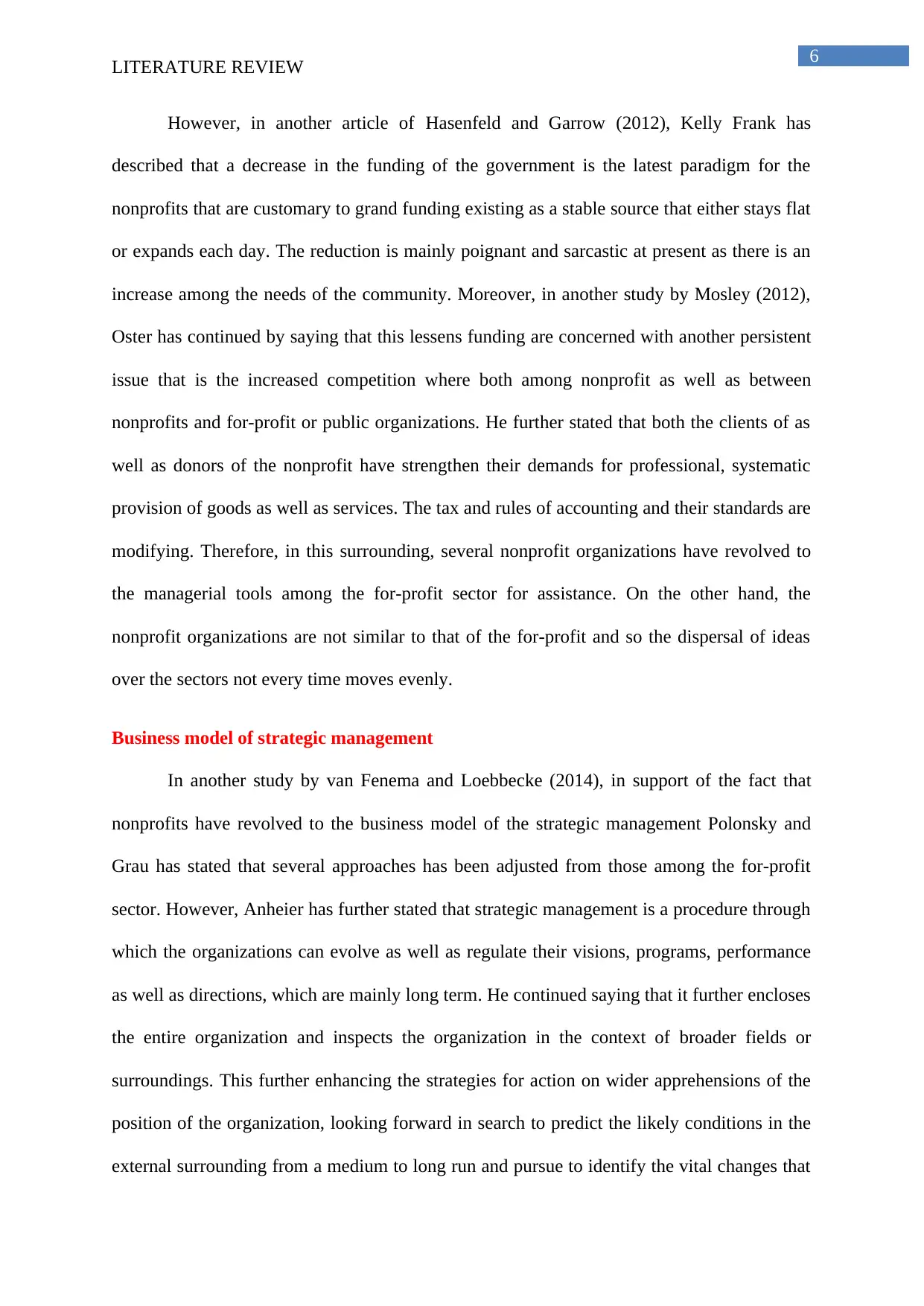
6
LITERATURE REVIEW
However, in another article of Hasenfeld and Garrow (2012), Kelly Frank has
described that a decrease in the funding of the government is the latest paradigm for the
nonprofits that are customary to grand funding existing as a stable source that either stays flat
or expands each day. The reduction is mainly poignant and sarcastic at present as there is an
increase among the needs of the community. Moreover, in another study by Mosley (2012),
Oster has continued by saying that this lessens funding are concerned with another persistent
issue that is the increased competition where both among nonprofit as well as between
nonprofits and for-profit or public organizations. He further stated that both the clients of as
well as donors of the nonprofit have strengthen their demands for professional, systematic
provision of goods as well as services. The tax and rules of accounting and their standards are
modifying. Therefore, in this surrounding, several nonprofit organizations have revolved to
the managerial tools among the for-profit sector for assistance. On the other hand, the
nonprofit organizations are not similar to that of the for-profit and so the dispersal of ideas
over the sectors not every time moves evenly.
Business model of strategic management
In another study by van Fenema and Loebbecke (2014), in support of the fact that
nonprofits have revolved to the business model of the strategic management Polonsky and
Grau has stated that several approaches has been adjusted from those among the for-profit
sector. However, Anheier has further stated that strategic management is a procedure through
which the organizations can evolve as well as regulate their visions, programs, performance
as well as directions, which are mainly long term. He continued saying that it further encloses
the entire organization and inspects the organization in the context of broader fields or
surroundings. This further enhancing the strategies for action on wider apprehensions of the
position of the organization, looking forward in search to predict the likely conditions in the
external surrounding from a medium to long run and pursue to identify the vital changes that
LITERATURE REVIEW
However, in another article of Hasenfeld and Garrow (2012), Kelly Frank has
described that a decrease in the funding of the government is the latest paradigm for the
nonprofits that are customary to grand funding existing as a stable source that either stays flat
or expands each day. The reduction is mainly poignant and sarcastic at present as there is an
increase among the needs of the community. Moreover, in another study by Mosley (2012),
Oster has continued by saying that this lessens funding are concerned with another persistent
issue that is the increased competition where both among nonprofit as well as between
nonprofits and for-profit or public organizations. He further stated that both the clients of as
well as donors of the nonprofit have strengthen their demands for professional, systematic
provision of goods as well as services. The tax and rules of accounting and their standards are
modifying. Therefore, in this surrounding, several nonprofit organizations have revolved to
the managerial tools among the for-profit sector for assistance. On the other hand, the
nonprofit organizations are not similar to that of the for-profit and so the dispersal of ideas
over the sectors not every time moves evenly.
Business model of strategic management
In another study by van Fenema and Loebbecke (2014), in support of the fact that
nonprofits have revolved to the business model of the strategic management Polonsky and
Grau has stated that several approaches has been adjusted from those among the for-profit
sector. However, Anheier has further stated that strategic management is a procedure through
which the organizations can evolve as well as regulate their visions, programs, performance
as well as directions, which are mainly long term. He continued saying that it further encloses
the entire organization and inspects the organization in the context of broader fields or
surroundings. This further enhancing the strategies for action on wider apprehensions of the
position of the organization, looking forward in search to predict the likely conditions in the
external surrounding from a medium to long run and pursue to identify the vital changes that
Paraphrase This Document
Need a fresh take? Get an instant paraphrase of this document with our AI Paraphraser
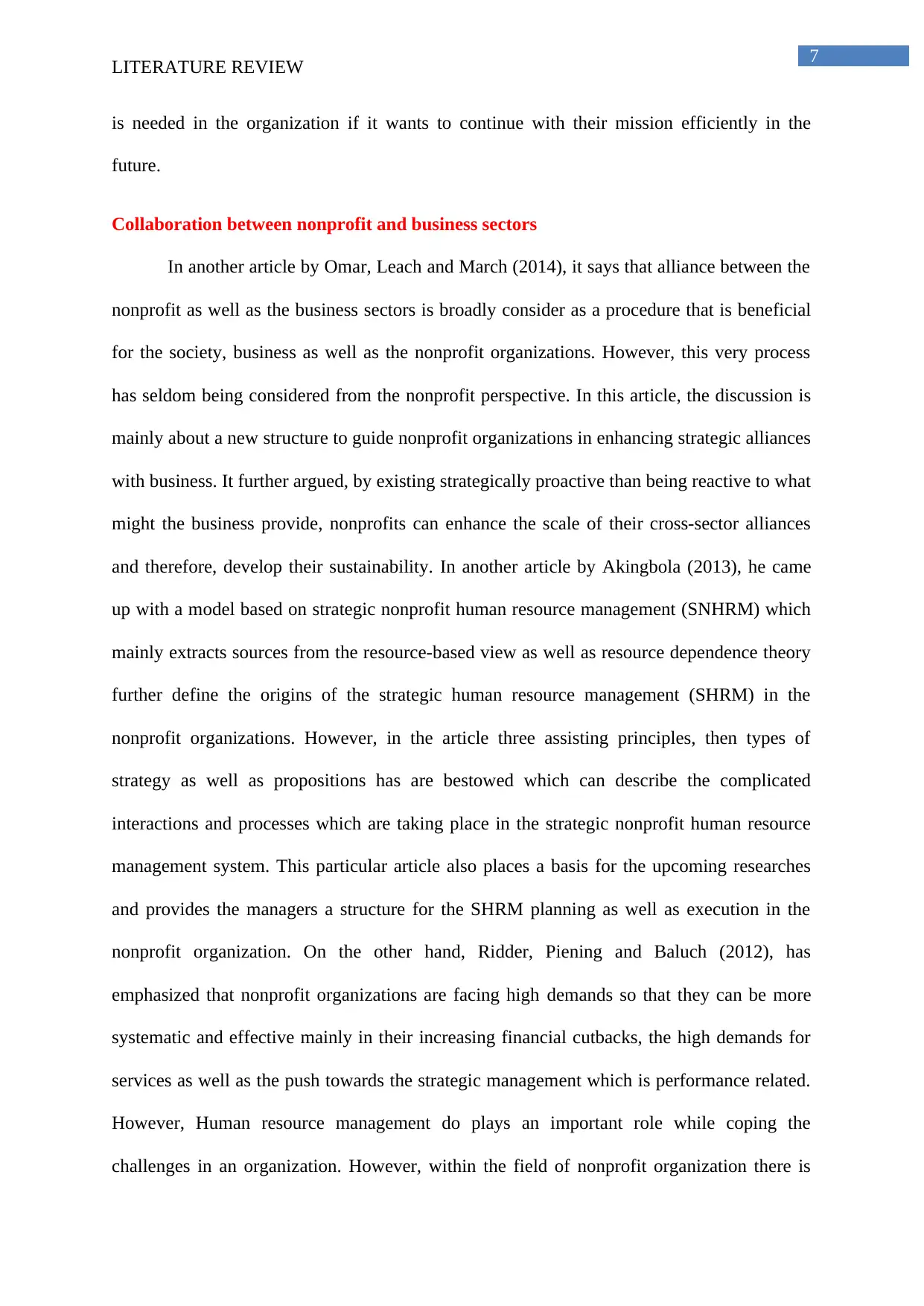
7
LITERATURE REVIEW
is needed in the organization if it wants to continue with their mission efficiently in the
future.
Collaboration between nonprofit and business sectors
In another article by Omar, Leach and March (2014), it says that alliance between the
nonprofit as well as the business sectors is broadly consider as a procedure that is beneficial
for the society, business as well as the nonprofit organizations. However, this very process
has seldom being considered from the nonprofit perspective. In this article, the discussion is
mainly about a new structure to guide nonprofit organizations in enhancing strategic alliances
with business. It further argued, by existing strategically proactive than being reactive to what
might the business provide, nonprofits can enhance the scale of their cross-sector alliances
and therefore, develop their sustainability. In another article by Akingbola (2013), he came
up with a model based on strategic nonprofit human resource management (SNHRM) which
mainly extracts sources from the resource-based view as well as resource dependence theory
further define the origins of the strategic human resource management (SHRM) in the
nonprofit organizations. However, in the article three assisting principles, then types of
strategy as well as propositions has are bestowed which can describe the complicated
interactions and processes which are taking place in the strategic nonprofit human resource
management system. This particular article also places a basis for the upcoming researches
and provides the managers a structure for the SHRM planning as well as execution in the
nonprofit organization. On the other hand, Ridder, Piening and Baluch (2012), has
emphasized that nonprofit organizations are facing high demands so that they can be more
systematic and effective mainly in their increasing financial cutbacks, the high demands for
services as well as the push towards the strategic management which is performance related.
However, Human resource management do plays an important role while coping the
challenges in an organization. However, within the field of nonprofit organization there is
LITERATURE REVIEW
is needed in the organization if it wants to continue with their mission efficiently in the
future.
Collaboration between nonprofit and business sectors
In another article by Omar, Leach and March (2014), it says that alliance between the
nonprofit as well as the business sectors is broadly consider as a procedure that is beneficial
for the society, business as well as the nonprofit organizations. However, this very process
has seldom being considered from the nonprofit perspective. In this article, the discussion is
mainly about a new structure to guide nonprofit organizations in enhancing strategic alliances
with business. It further argued, by existing strategically proactive than being reactive to what
might the business provide, nonprofits can enhance the scale of their cross-sector alliances
and therefore, develop their sustainability. In another article by Akingbola (2013), he came
up with a model based on strategic nonprofit human resource management (SNHRM) which
mainly extracts sources from the resource-based view as well as resource dependence theory
further define the origins of the strategic human resource management (SHRM) in the
nonprofit organizations. However, in the article three assisting principles, then types of
strategy as well as propositions has are bestowed which can describe the complicated
interactions and processes which are taking place in the strategic nonprofit human resource
management system. This particular article also places a basis for the upcoming researches
and provides the managers a structure for the SHRM planning as well as execution in the
nonprofit organization. On the other hand, Ridder, Piening and Baluch (2012), has
emphasized that nonprofit organizations are facing high demands so that they can be more
systematic and effective mainly in their increasing financial cutbacks, the high demands for
services as well as the push towards the strategic management which is performance related.
However, Human resource management do plays an important role while coping the
challenges in an organization. However, within the field of nonprofit organization there is
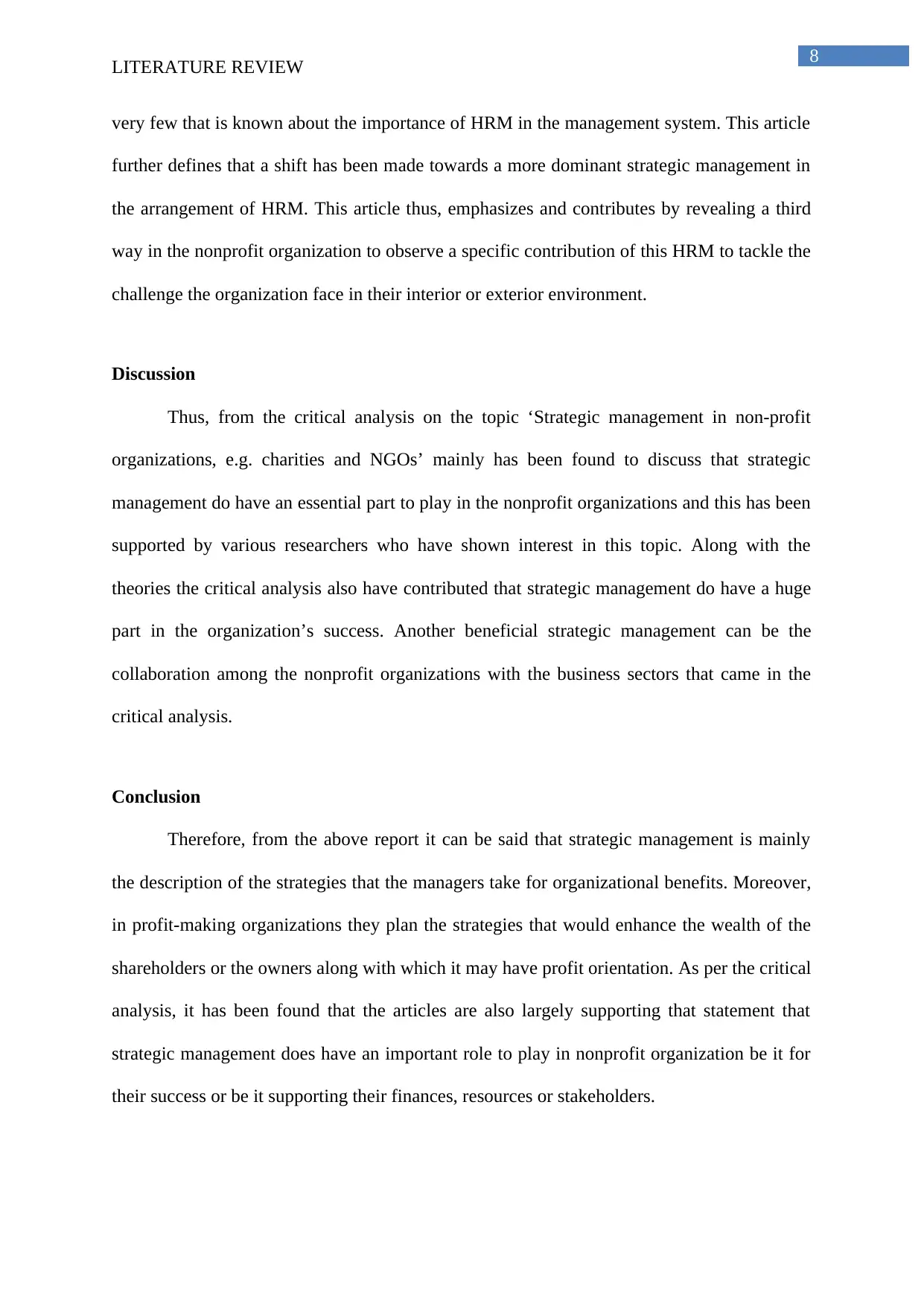
8
LITERATURE REVIEW
very few that is known about the importance of HRM in the management system. This article
further defines that a shift has been made towards a more dominant strategic management in
the arrangement of HRM. This article thus, emphasizes and contributes by revealing a third
way in the nonprofit organization to observe a specific contribution of this HRM to tackle the
challenge the organization face in their interior or exterior environment.
Discussion
Thus, from the critical analysis on the topic ‘Strategic management in non-profit
organizations, e.g. charities and NGOs’ mainly has been found to discuss that strategic
management do have an essential part to play in the nonprofit organizations and this has been
supported by various researchers who have shown interest in this topic. Along with the
theories the critical analysis also have contributed that strategic management do have a huge
part in the organization’s success. Another beneficial strategic management can be the
collaboration among the nonprofit organizations with the business sectors that came in the
critical analysis.
Conclusion
Therefore, from the above report it can be said that strategic management is mainly
the description of the strategies that the managers take for organizational benefits. Moreover,
in profit-making organizations they plan the strategies that would enhance the wealth of the
shareholders or the owners along with which it may have profit orientation. As per the critical
analysis, it has been found that the articles are also largely supporting that statement that
strategic management does have an important role to play in nonprofit organization be it for
their success or be it supporting their finances, resources or stakeholders.
LITERATURE REVIEW
very few that is known about the importance of HRM in the management system. This article
further defines that a shift has been made towards a more dominant strategic management in
the arrangement of HRM. This article thus, emphasizes and contributes by revealing a third
way in the nonprofit organization to observe a specific contribution of this HRM to tackle the
challenge the organization face in their interior or exterior environment.
Discussion
Thus, from the critical analysis on the topic ‘Strategic management in non-profit
organizations, e.g. charities and NGOs’ mainly has been found to discuss that strategic
management do have an essential part to play in the nonprofit organizations and this has been
supported by various researchers who have shown interest in this topic. Along with the
theories the critical analysis also have contributed that strategic management do have a huge
part in the organization’s success. Another beneficial strategic management can be the
collaboration among the nonprofit organizations with the business sectors that came in the
critical analysis.
Conclusion
Therefore, from the above report it can be said that strategic management is mainly
the description of the strategies that the managers take for organizational benefits. Moreover,
in profit-making organizations they plan the strategies that would enhance the wealth of the
shareholders or the owners along with which it may have profit orientation. As per the critical
analysis, it has been found that the articles are also largely supporting that statement that
strategic management does have an important role to play in nonprofit organization be it for
their success or be it supporting their finances, resources or stakeholders.
⊘ This is a preview!⊘
Do you want full access?
Subscribe today to unlock all pages.

Trusted by 1+ million students worldwide
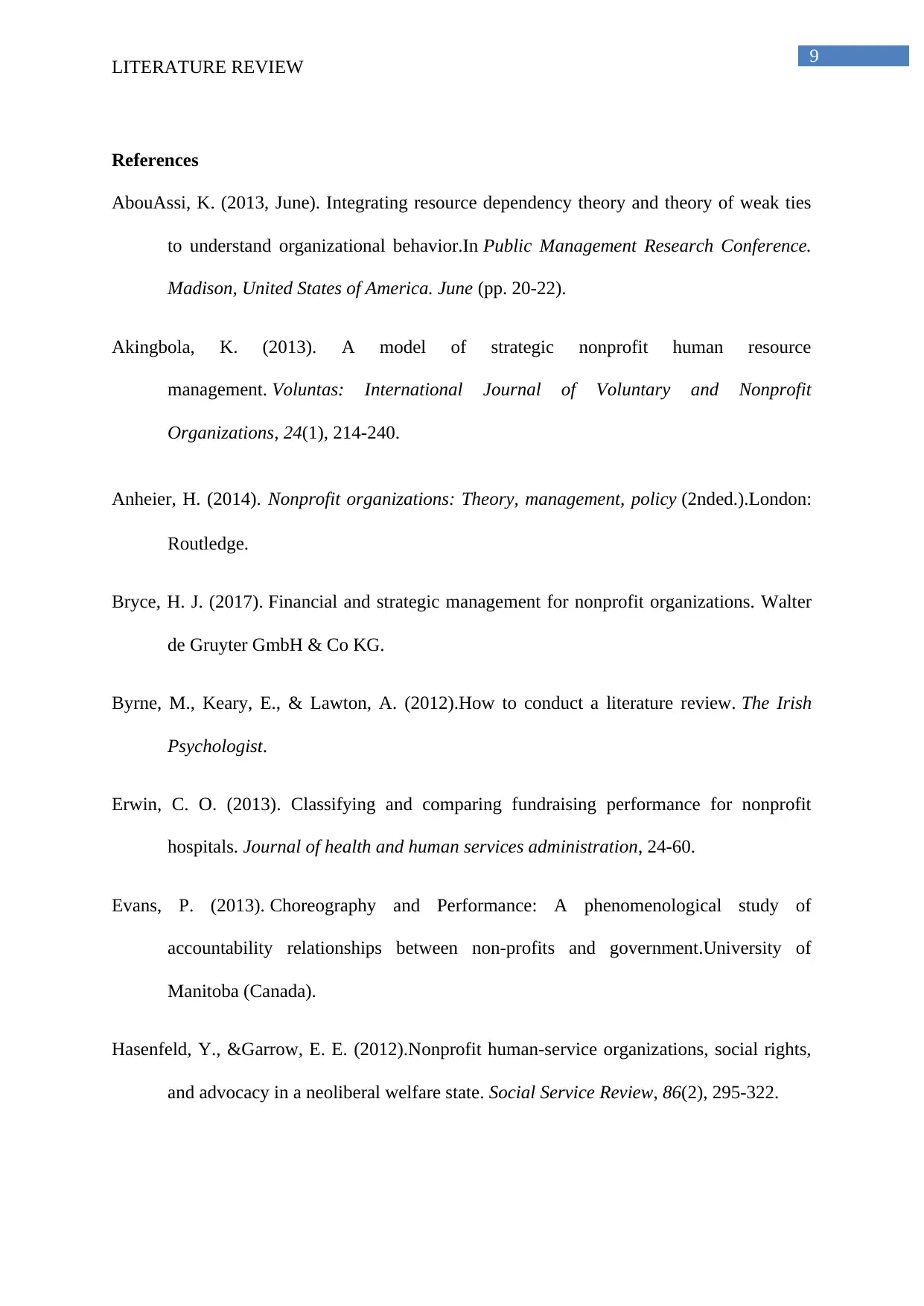
9
LITERATURE REVIEW
References
AbouAssi, K. (2013, June). Integrating resource dependency theory and theory of weak ties
to understand organizational behavior.In Public Management Research Conference.
Madison, United States of America. June (pp. 20-22).
Akingbola, K. (2013). A model of strategic nonprofit human resource
management. Voluntas: International Journal of Voluntary and Nonprofit
Organizations, 24(1), 214-240.
Anheier, H. (2014). Nonprofit organizations: Theory, management, policy (2nded.).London:
Routledge.
Bryce, H. J. (2017). Financial and strategic management for nonprofit organizations. Walter
de Gruyter GmbH & Co KG.
Byrne, M., Keary, E., & Lawton, A. (2012).How to conduct a literature review. The Irish
Psychologist.
Erwin, C. O. (2013). Classifying and comparing fundraising performance for nonprofit
hospitals. Journal of health and human services administration, 24-60.
Evans, P. (2013). Choreography and Performance: A phenomenological study of
accountability relationships between non-profits and government.University of
Manitoba (Canada).
Hasenfeld, Y., &Garrow, E. E. (2012).Nonprofit human-service organizations, social rights,
and advocacy in a neoliberal welfare state. Social Service Review, 86(2), 295-322.
LITERATURE REVIEW
References
AbouAssi, K. (2013, June). Integrating resource dependency theory and theory of weak ties
to understand organizational behavior.In Public Management Research Conference.
Madison, United States of America. June (pp. 20-22).
Akingbola, K. (2013). A model of strategic nonprofit human resource
management. Voluntas: International Journal of Voluntary and Nonprofit
Organizations, 24(1), 214-240.
Anheier, H. (2014). Nonprofit organizations: Theory, management, policy (2nded.).London:
Routledge.
Bryce, H. J. (2017). Financial and strategic management for nonprofit organizations. Walter
de Gruyter GmbH & Co KG.
Byrne, M., Keary, E., & Lawton, A. (2012).How to conduct a literature review. The Irish
Psychologist.
Erwin, C. O. (2013). Classifying and comparing fundraising performance for nonprofit
hospitals. Journal of health and human services administration, 24-60.
Evans, P. (2013). Choreography and Performance: A phenomenological study of
accountability relationships between non-profits and government.University of
Manitoba (Canada).
Hasenfeld, Y., &Garrow, E. E. (2012).Nonprofit human-service organizations, social rights,
and advocacy in a neoliberal welfare state. Social Service Review, 86(2), 295-322.
Paraphrase This Document
Need a fresh take? Get an instant paraphrase of this document with our AI Paraphraser
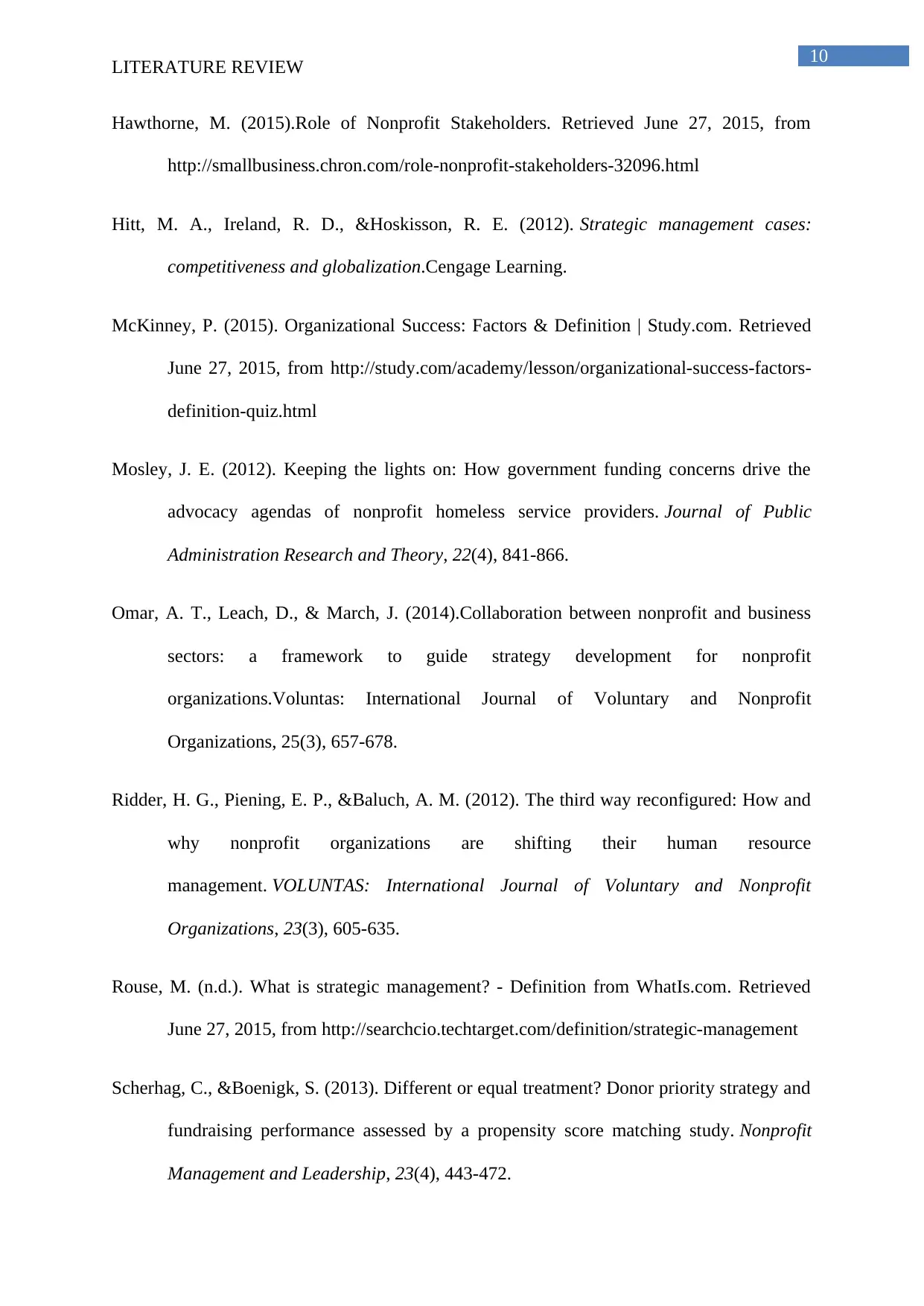
10
LITERATURE REVIEW
Hawthorne, M. (2015).Role of Nonprofit Stakeholders. Retrieved June 27, 2015, from
http://smallbusiness.chron.com/role-nonprofit-stakeholders-32096.html
Hitt, M. A., Ireland, R. D., &Hoskisson, R. E. (2012). Strategic management cases:
competitiveness and globalization.Cengage Learning.
McKinney, P. (2015). Organizational Success: Factors & Definition | Study.com. Retrieved
June 27, 2015, from http://study.com/academy/lesson/organizational-success-factors-
definition-quiz.html
Mosley, J. E. (2012). Keeping the lights on: How government funding concerns drive the
advocacy agendas of nonprofit homeless service providers. Journal of Public
Administration Research and Theory, 22(4), 841-866.
Omar, A. T., Leach, D., & March, J. (2014).Collaboration between nonprofit and business
sectors: a framework to guide strategy development for nonprofit
organizations.Voluntas: International Journal of Voluntary and Nonprofit
Organizations, 25(3), 657-678.
Ridder, H. G., Piening, E. P., &Baluch, A. M. (2012). The third way reconfigured: How and
why nonprofit organizations are shifting their human resource
management. VOLUNTAS: International Journal of Voluntary and Nonprofit
Organizations, 23(3), 605-635.
Rouse, M. (n.d.). What is strategic management? - Definition from WhatIs.com. Retrieved
June 27, 2015, from http://searchcio.techtarget.com/definition/strategic-management
Scherhag, C., &Boenigk, S. (2013). Different or equal treatment? Donor priority strategy and
fundraising performance assessed by a propensity score matching study. Nonprofit
Management and Leadership, 23(4), 443-472.
LITERATURE REVIEW
Hawthorne, M. (2015).Role of Nonprofit Stakeholders. Retrieved June 27, 2015, from
http://smallbusiness.chron.com/role-nonprofit-stakeholders-32096.html
Hitt, M. A., Ireland, R. D., &Hoskisson, R. E. (2012). Strategic management cases:
competitiveness and globalization.Cengage Learning.
McKinney, P. (2015). Organizational Success: Factors & Definition | Study.com. Retrieved
June 27, 2015, from http://study.com/academy/lesson/organizational-success-factors-
definition-quiz.html
Mosley, J. E. (2012). Keeping the lights on: How government funding concerns drive the
advocacy agendas of nonprofit homeless service providers. Journal of Public
Administration Research and Theory, 22(4), 841-866.
Omar, A. T., Leach, D., & March, J. (2014).Collaboration between nonprofit and business
sectors: a framework to guide strategy development for nonprofit
organizations.Voluntas: International Journal of Voluntary and Nonprofit
Organizations, 25(3), 657-678.
Ridder, H. G., Piening, E. P., &Baluch, A. M. (2012). The third way reconfigured: How and
why nonprofit organizations are shifting their human resource
management. VOLUNTAS: International Journal of Voluntary and Nonprofit
Organizations, 23(3), 605-635.
Rouse, M. (n.d.). What is strategic management? - Definition from WhatIs.com. Retrieved
June 27, 2015, from http://searchcio.techtarget.com/definition/strategic-management
Scherhag, C., &Boenigk, S. (2013). Different or equal treatment? Donor priority strategy and
fundraising performance assessed by a propensity score matching study. Nonprofit
Management and Leadership, 23(4), 443-472.

11
LITERATURE REVIEW
vanFenema, P. C., &Loebbecke, C. (2014). Towards a framework for managing strategic
tensions in dyadic interorganizational relationships. Scandinavian Journal of
Management, 30(4), 516-524.
LITERATURE REVIEW
vanFenema, P. C., &Loebbecke, C. (2014). Towards a framework for managing strategic
tensions in dyadic interorganizational relationships. Scandinavian Journal of
Management, 30(4), 516-524.
⊘ This is a preview!⊘
Do you want full access?
Subscribe today to unlock all pages.

Trusted by 1+ million students worldwide
1 out of 15
Related Documents
Your All-in-One AI-Powered Toolkit for Academic Success.
+13062052269
info@desklib.com
Available 24*7 on WhatsApp / Email
![[object Object]](/_next/static/media/star-bottom.7253800d.svg)
Unlock your academic potential
Copyright © 2020–2025 A2Z Services. All Rights Reserved. Developed and managed by ZUCOL.





